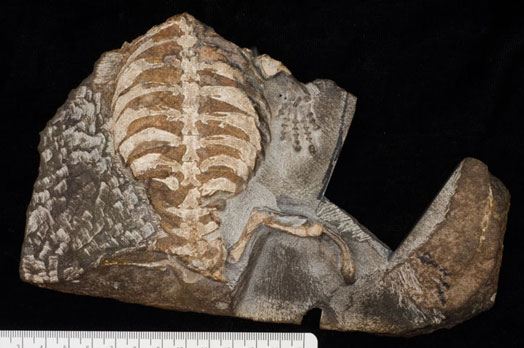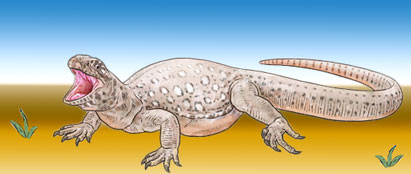The Turtle Shell Evolved to Help with Burrowing
Fossorial Origins of the Turtle Shell – Eunotosaurus africanus
Writing in the “Current Biology” a team of international scientists, led by Dr Tyler Lyson (Denver Museum of Nature and Science), have concluded that the “shell” of turtles, terrapins and tortoises evolved not for protection but as an adaptation for burrowing and living underground. As the feather did not evolve for flight, so then the carapace (top) and plastron (underneath) of the SuperOrder Chelonia, may not have evolved as a shield. Like flight feathers, the shell of a tortoise and its use in defence was a secondary outcome of an evolutionary process.
The Origins of the Turtle Shell
Fossils excavated from the famous Permian-aged deposits of the Karoo Basin (South Africa) suggest that the earliest evolutionary beginnings of the turtle’s shell resulted from adaptations to accommodate a burrowing or fossorial (digging) lifestyle.
Karoo Basin Fossils of the Proto-Turtle Eunotosaurus Indicate Fossorial Adaptations

The proto-turtle Eunotosaurus burrows into the banks of a dried up pond to survive in the harsh, arid South African environment about 260 million years ago. In the background, a herd of Bradysaurus, a type of reptile, crowds around some muddy water.
Picture credit: Audrey Atuchin
A Widening of the Ribs
Dr Lyson had the opportunity to learn more about chelonian evolution when he, along with collaborators form the Smithsonian Institute studied the fossilised remains of a highly specialised parareptile, Eunotosaurus africanus, back in 2013. These fossils, which also came from Late Permian aged deposits in South Africa, indicated that a widening of the ribs was the first stage in the evolution of the shell.
To read more about the origins of the shell in turtles: How the Turtle Got Its Shell.
Tyler Lyson explained: “We knew from both the fossil record and observing how the turtle shell develops in modern turtles that one of the first major changes toward a shell was the broadening of the ribs.”
An Effect on Mobility
However, for a quadruped, the widening of the ribs has a very serious effect on mobility. Breathing is restricted and movement becomes more difficult. Ribs are primarily used to support the torso during locomotion and they play a vital role in lung function. Broader ribs, means a stiffer body which will lead to a shortening of stride length and less efficient breathing. In the harsh and dangerous world of the Permian, these modifications would have seriously disadvantaged any tetrapod.
Rib bones in vertebrates show hardly any variation, team members at Everything Dinosaur have recently been examining the rib bones of a prehistoric elephant, these ribs are very similar to the ribs of a large dinosaur such as a Stegosaurus. The Chelonia are an exception, their ribs are highly modified as they form the majority of the shell.
A Significant Fossil Discovery
The discovery of several, exceptionally well-preserved specimens of Eunotosaurus africanus allowed the team to examine shell evolution in much more detail than before. A number of the fossils were found by the study’s co-authors, doctors Roger Smith and Bruce Rubidge (University of Witwatersrand, Johannesburg). However, the most important specimen used in this study was found by a young boy on his father’s farm in the Western Cape. Eight-year old Kobus Snyman, took the fossil that he found to his local museum, the Fransie Pienaar Museum in Prince Albert (Western Cape). The articulated fossil measures around fifteen centimetres in length, the body (and those all important ribs) are preserved along with the hands and feet but the skull is missing.
Praising Observational Skills
Dr Lyson praised young Kobus for his observational skills and for taking his find to the local museum, he stated:
“I want to thank Kobus Snyman and shake his hand because without Kobus both finding the specimen and taking it to his local museum, this study would not have been possible.”
The Eunotosaurus Fossil Found by Kobus Snyman
Picture credit: Dr. Tyler Lyson
Extant turtles, terrapins and tortoises have shells that serve mainly as protective devices. These armoured animals are notoriously slow. However, in this new study, developmental evidence from embryos combined with these newly described Karoo Basin fossils suggest that one of the first steps towards the shelled body-plan was a widening of the ribs. Eunotosaurus africanus is thought to be a basal member of the Chelonia and the broad ribs of this animal have been proposed as support and stabilising mechanisms to help support a powerful forelimb digging action. The adaptations for a fossorial lifestyle would have facilitated the movement of stem turtles into aquatic environments early in the group’s evolutionary history.
In the scientific paper, entitled “Fossorial Origin of the Turtle Shell”, the researchers propose that adaptations related to digging provided the initial impetus for shell development and that the fosssorial lifestyle may explain why basal turtles survived the catastrophe that marked the end of the Palaeozoic (End Permian mass extinction event).
To read an article from Everything Dinosaur that suggest that turtles and their kind evolved from diapsid reptiles: Study Suggests Chelonia Evolved from Diapsids.
An Illustration of Eunotosaurus africanus
Picture credit: Everything Dinosaur
An article on a Mid Jurassic turtle discovery: The Grandfather of All Tortoises and Turtles.



